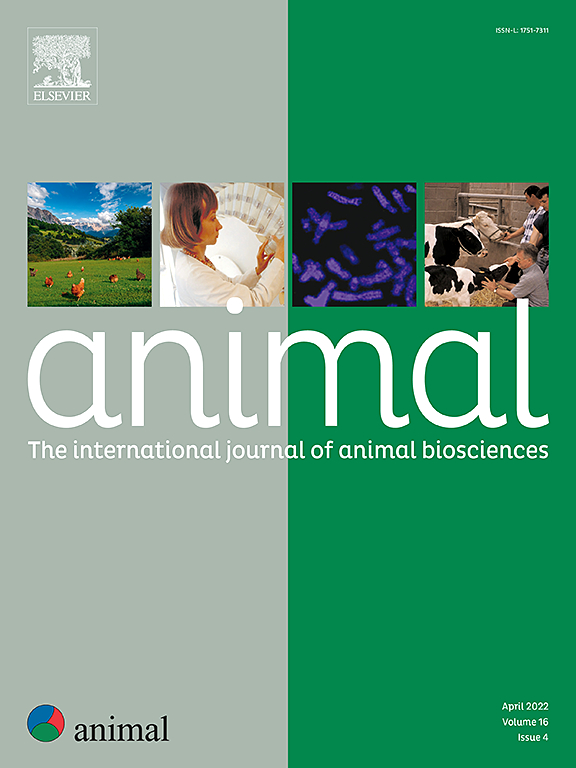黑虻活幼虫的贮藏:温度和贮藏技术的影响
IF 4.2
2区 农林科学
Q1 AGRICULTURE, DAIRY & ANIMAL SCIENCE
引用次数: 0
摘要
在养殖动物中使用黑氏活幼虫对其行为、福利和健康产生了积极影响。然而,昆虫饲养设施可能不在接收活幼虫的养殖场附近。在低温下储存和运输可能是保存幼虫直到食用的必要条件。本研究的目的是评价不同贮藏方法冷藏活仔鱼的可行性。试验处理(每个5个重复)为:数量(1 kg或3 kg)、容器类型(桶或袋)、添加(或不添加)草和储存温度(6°C、8°C和10°C)。每天从每个重复取幼虫,计数活幼虫和死幼虫,记录活幼虫的重量。当15%的幼虫死亡时,认为一个重复结束。数据采用广义线性混合模型([GLMM] IBM SPSS软件,P≤0.05)进行分析。在所有测试条件下都可以储存黑兵蝇幼虫,损失低于15%,存贮期低于6天。温度起主要作用,10°C允许最长的使用寿命(P < 0.001)。添加草料、大量储存和使用聚丙烯袋可延长幼虫寿命(P < 0.001),使用袋代替桶可降低死亡率(P < 0.01)。为了延长幼虫的储存时间,代价是体重的减少。本文章由计算机程序翻译,如有差异,请以英文原文为准。
Storing live black soldier fly larvae: the influence of temperature and storage techniques
The use of live larvae of Hermetia illucens for farmed animals has shown positive influence on their behaviour, welfare and health. However, insect rearing facilities may not be in the immediate proximity of the farm that will receive the live larvae. Storage and transport at low temperatures could be then necessary to preserve the larvae until consumption. The aim of this study is to evaluate the feasibility of storing live larvae at cold temperature with different storage methods. Tested treatments (5 replicates each) were: quantity (1 kg or 3 kg), type of container (bucket or bag), the addition (or not) of frass and storage temperature (6 °C, 8 °C and 10 °C). Larvae samples were daily taken from each replicate, live and dead larvae were counted, and the weight of the live larvae was recorded. A replicate was considered over when 15% of the larvae were dead. Data were analysed by means of generalized linear mixed models ([GLMM] IBM SPSS software, P ≤ 0.05). Storing black soldier fly larvae is possible in all the tested conditions, with losses below 15% and for periods below 6 days. The temperature plays a major role, with 10°C allowing the longest lifespan (P < 0.001). The addition of frass, storing larger quantities of larvae and using polypropylene bags were the treatments which enhanced larval lifespan (P < 0.001), while the use of bags instead of buckets reduced mortality (P < 0.01). The trade-off for longer storage of the larvae is a higher weight loss.
求助全文
通过发布文献求助,成功后即可免费获取论文全文。
去求助
来源期刊

Animal
农林科学-奶制品与动物科学
CiteScore
7.50
自引率
2.80%
发文量
246
审稿时长
3 months
期刊介绍:
Editorial board
animal attracts the best research in animal biology and animal systems from across the spectrum of the agricultural, biomedical, and environmental sciences. It is the central element in an exciting collaboration between the British Society of Animal Science (BSAS), Institut National de la Recherche Agronomique (INRA) and the European Federation of Animal Science (EAAP) and represents a merging of three scientific journals: Animal Science; Animal Research; Reproduction, Nutrition, Development. animal publishes original cutting-edge research, ''hot'' topics and horizon-scanning reviews on animal-related aspects of the life sciences at the molecular, cellular, organ, whole animal and production system levels. The main subject areas include: breeding and genetics; nutrition; physiology and functional biology of systems; behaviour, health and welfare; farming systems, environmental impact and climate change; product quality, human health and well-being. Animal models and papers dealing with the integration of research between these topics and their impact on the environment and people are particularly welcome.
 求助内容:
求助内容: 应助结果提醒方式:
应助结果提醒方式:


